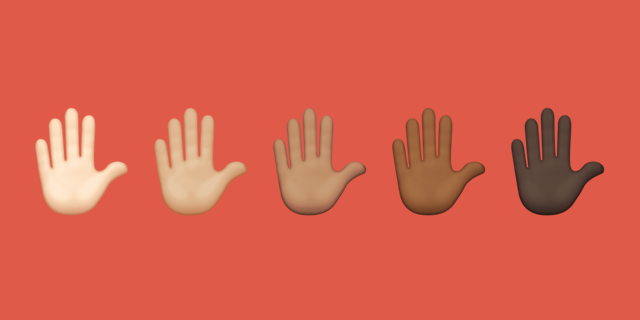Use skin tone emoji that match your skin
The missing help page for white @SlackHQ users 2021-05-11 #learning

The emoji problem often makes me uncertain which emoji to use, for example because different platforms use different graphics or when I message someone whose in-crowd has their own ‘slang’, as with other kinds of colloquial language. Emoji skin tones introduced more variation I didn’t know how to deal with at first.

If you don’t use Slack, you might never even think about this particular choice. This article addresses people who do want the short answer to the question of which skin tone emoji to use.
Use the light skin tone if you’re white
For a while I didn’t know what to do. I’ve seen people rationalise sticking to the yellow default, using a ‘white’ skin tone, and also using a darker colour. Fortunately, searching the web and talking to some people of colour revealed the answer.
Use the light skin tone. Ideally, don’t stop there: explore the question, and read and listen to diverse voices. Remember that a skin colour you didn’t choose deserves neither your pride nor your shame. And not hiding personal characteristics you can’t change doesn’t constitute making a statement. 👍🏻
Use the skin tone closest to your skin colour
In general, you should use the emoji skin tone modifier that most closely matches your skin’s actual colour. Bring yourself to online conversations.
Emoji skin tones use the Fitzpatrick scale, which classifies how different skin types respond to ultraviolet light, which corresponds to skin colour.
- types 1-2 (always burns, never tans) and (usually burns, tans minimally)
- type 3 (sometimes mild burn, tans uniformly)
- type 4 (burns minimally, always tans well)
- type 5 (very rarely burns, tans very easily)
- type 6 (never burns)
This classification may help you more than what these emoji look like on your screen, or not. And while you might want to opt out of this kind of choice, the default yellow emoji doesn’t give you that. 👎
Yellow isn’t neutral
The Simpsons’ yellow cartoon characters provide the most memorable precursor to yellow emoji for a lot of people. In the show, only white characters have yellow skin. Non-white characters, such as Indian-American Apu Nahasapeemapetilon, have (cartoon versions of) darker skin colours.
Don’t use a darker tone than your actual skin colour
I’ve occasionally seen white people use darker skin tone emoji in an attempt to promote diversity. Unfortunately, good intentions notwithstanding, this fake diversity really doesn’t help.
Emma Dabiri calls this performative allyship (a.k.a. performative activism or slacktivism): it makes the performer look good without making a difference to the people it purports to help.
Learn and do more
Read more about inclusion and emoji:
- Should white people use white skin tone emojis?, by Valerie Aurora
- The problem with emoji skin tones that no one talks about, by Zara Rahman
- Apple did not invent emoji, by @eevee
More importantly, I’ve learned that inclusion takes more than emoji in a Slack channel. Listening to people of colour, hiring more of them and paying them more will actually help.
Thanks to Naya Moss, Paula Muldoon, Samir Talwar and others for feedback on a draft of this article.

